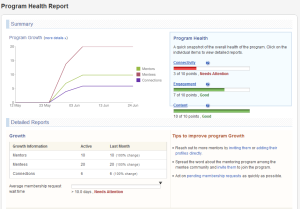Developing your employees requires time and effort. Successful employee development programs not only arm the employee with lifelong skill sets, but also demonstrate organizational trust and eagerness to drive employee growth and retention. Even so, an employee development program is particularly tricky to sustain and with the wrong approach, may end up becoming more of a liability than an opportunity for both the company and the employee.
In the current world of fast-growing technology and the “war for talent” environment, many businesses are experiencing a deficit in employee engagement as well as employee retention. Studies have shown that organizations with employee development programs are six times more likely to increase employee engagement and have a 2.5 times higher productivity rate than organizations that have yet to implement a career development strategy (Scales, 2012).
Additionally, adopting a “pull” strategy for learning can reap big benefits. As stated recently in a Bersin by Deloitte report, Global Human Capital Trends 2014, “In a ‘pull’ learning environment, workers take it upon themselves to find information, educate themselves, and share their own expertise. In fact […] research shows that creating this type of learning culture, where employees willingly share skills and knowledge, is now one of the most important factors in business success.”

1. Define your employee development program objectives and secure leadership support.
You’d be surprised by the number of employee career development programs without clear objectives or strong buy-in. Such programs often struggle because there is no consensus of what success looks like. Good objectives are SMART—specific, measurable, attainable, relevant, and time bound. Program objectives provide direction for program participants and help organizational leaders understand why they should offer their support. If your goal is to retain talent in your organization, plan to measure the attrition rate of your program. Conduct an employee satisfaction survey at the end of every quarter, and compare these results over time to improve program effectiveness. Make sure to identify a senior leader who believes strongly in the program and is willing to serve as its executive champion. This person will prove to be a critical resource and advocate.
2. Find a strong program director or executive sponsorship.
Selecting the right program manager is critical to your development program. A strong program manager doesn’t guarantee success, but a weak one will guarantee underwhelming results. Program managers provide essential ongoing support, training, and coaching to participants. They identify opportunities and troubleshoot issues, working with stakeholders to make ongoing adjustments to keep the program thriving. They are also instrumental in promoting the program to potential participants and serve as the program’s ambassador to the organization. Passion, excellent communication, and organizational skills are a must. Prior experience in serving as a program director is a bonus.
Download Your Full Employee Development Ebook
3. Build flexibility into your employee development plan.
Successful employee career development programs balance the dueling needs of structure and flexibility. You’ll need a level of formality within the development process: participant training, progress tracking, and communication to help the program run smoothly. Yet mentoring and coaching types of development programs are about individual learning and growth, which means participant needs vary in outcomes and preferred methods. When planning an employee career development program, identify areas that require flexibility and build them into the program. Areas to consider include program format (one-to-one, group), duration, and participant interaction tools.
4. Put on your marketing hat.
When introducing new employee career development programs in organizations, generated enthusiasm doesn’t always translate to high participation rates. A common reason is the absence of effective promotion. Don’t assume potential participants understand the benefits. You’ll need to convince them that participation is worth their time and effort. Get creative in spreading word of mouth about your program through internal promotions. Some of the tactics that Chronus customers have used include lunch and learns, internal emails, parties that coincide with participation, milestones, and presentations at company meetings. Don’t limit yourself to any one method. Mix it up and keep evangelizing your program. Check out our promotional toolkit for ideas and templates to get you started.
Get mentoring resources straight to your inbox. Subscribe today!
5. Prepare participants for success.
Provide training to participants regarding the program’s goals, participant roles, best practices, and your training process. Help mentors, mentees, coaches, and coachees clarify their own objectives. The need for training and guidance doesn’t end after the initial orientation. Provide tips and best practices throughout their training to help participants stay on track and get the most out of the program.
6. Embrace the role of matchmaker.
For employee career development to thrive, it’s key to form a solid relationship between the mentors/coaches and the employee. A critical step in the learning process is accurately matching mentors/coaches to employees. This is where program management software can improve and speed up the matching process. Instead of doing tedious, administrative hand-matching, software can generate intelligent matches based on gender, skills, and similar company and/or university experiences. Or, set up your program to employ self-matching, where employees can sign up and choose their own coaches or mentors.
7. Use software to manage, measure, and tune your employee development program.
Using mentoring software can streamline the administration of your program, provide participant workflows and milestones, track progress, and generate success metrics. Once your program is launched, software can provide engagement insight into the mentoring and coaching connections to ensure your pairings are on track. Software can also help you generate those vital ROI metrics for reporting your program’s success to the powers that be.
8. Broadcast successes.
After an employee career development program begins, the focus naturally shifts into operating the program and keeping it running smoothly. In order to demonstrate the value of the mentoring and coaching program to both potential and existing participants, continue to recognize their contributions and spotlight these successes throughout the course of the program. These efforts will bring energy to the program, expand participation, and increase overall support within the organization.
Conclusion
We hope we’ve given you a good head start on creating an employee career development plan and program that uses a “pull” learning approach in which employees can connect to learn and share expertise. Corporate mentoring and coaching programs provide an excellent structure to enable this style of learning, which is widely regarded as the best way to develop new skills and retain that knowledge for years to come.



